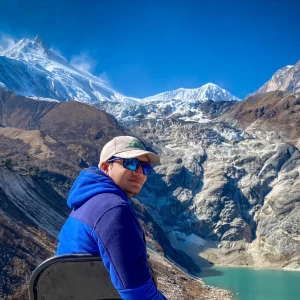Trekking to Everest Base Camp no longer means discomfort and long, difficult walks both ways. The luxury Everest Base Camp trek is a smooth, well-planned journey built around comfort, safety, and timesaving.
Instead of staying in basic tea houses, you rest in heated lodges with privacy, en-suite bathrooms, and proper food.
Rather than walking back the same trail for days, you fly back to Kathmandu by helicopter from Gorak Shep.
This trip is built for travellers who want to enjoy the full Himalayan experience, without giving up their everyday comfort. It focuses on your well-being, efficient altitude adjustment, and cultural immersion in Sherpa villages along the trail.
With dedicated guides, porters, and trusted logistics, every step of the journey is prepared ahead of your arrival. Each day is designed for better sleep, acclimatisation, and meaningful connection with the Khumbu region’s natural and spiritual beauty.
The luxury Everest Base Camp trek suits those who value their time, prefer clear plans, and enjoy purposeful travel.
🗓️ Planning for 2025 or 2026?
👉 Check Availability or Inquire for Custom Dates
What is the Luxury Everest Base Camp Trek?
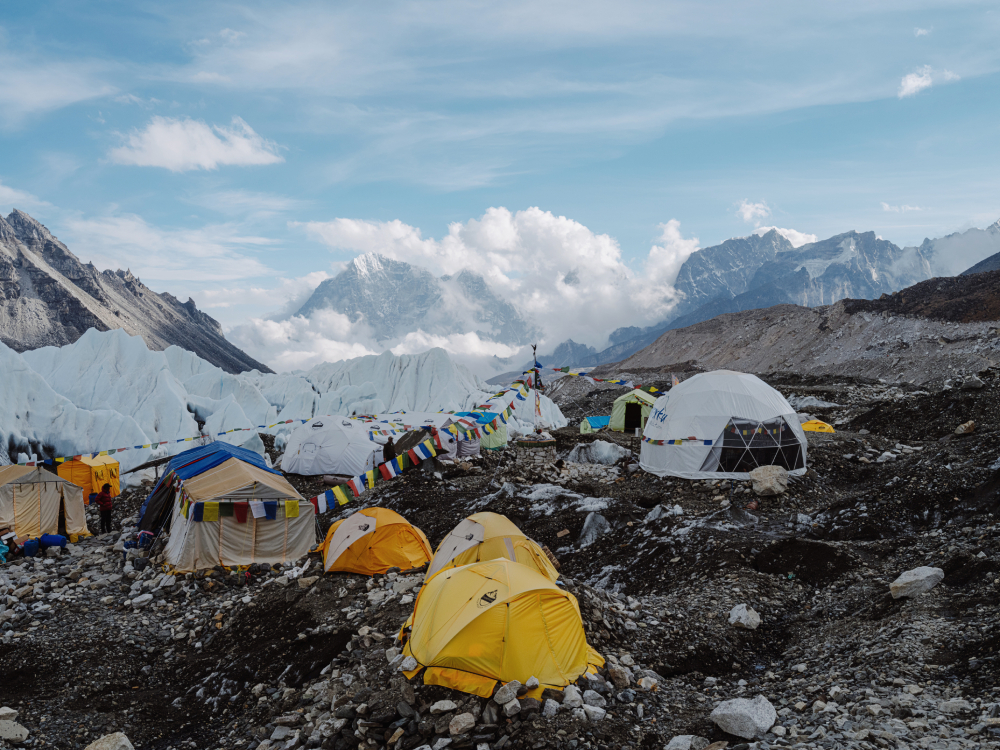
The luxury Everest Base Camp trek is a curated high-altitude experience supported by exclusive infrastructure and personalised service. Unlike basic trekking routes, this journey uses a network of purpose-built luxury lodges, not upgraded tea houses.
Each lodge is designed for trekkers who expect comfort and privacy in remote settings. You stay in brand-name lodges like Yeti Mountain Home, known for their quality and consistency.
Rooms come with clean beds, real duvets, private or semi-private bathrooms, and access to hot water (often solar-heated). Some lodges provide heated blankets, in-room dining, and locally sourced meals prepared in sanitised kitchens.
Every part of this trek is pre-arranged: your rooms are booked in advance, meals are scheduled, and daily plans are coordinated. An experienced local guide sets your walking pace, while Sherpa porters carry your main luggage securely.
This version of the Everest Base Camp trek is built for people who value time, safety, and comfort in remote environments.
If you’re not sure how this differs from the traditional trek, here’s a direct link:
Compare with the Regular Everest Base Camp Trek
Why Choose a Luxury Everest Trek in 2025?
The luxury Everest Base Camp trek offers built-in comfort, which directly improves altitude adaptation and sleep recovery. You stay in insulated lodges with thicker bedding, quieter interiors, and access to hot water where possible.
Dining areas remain heated, often by yak-dung stoves, which helps reduce cold-related fatigue during evenings. Up to Dingboche, most rooms offer attached bathrooms and limited electric support for warm blankets or charging.
Above 4,400 meters, shared facilities become common due to solar power limitations and the lack of piped water. This structure ensures trekkers maintain energy and hygiene, even during multi-day hikes over 4,000 meters.
Helicopter Access and Time Efficiency
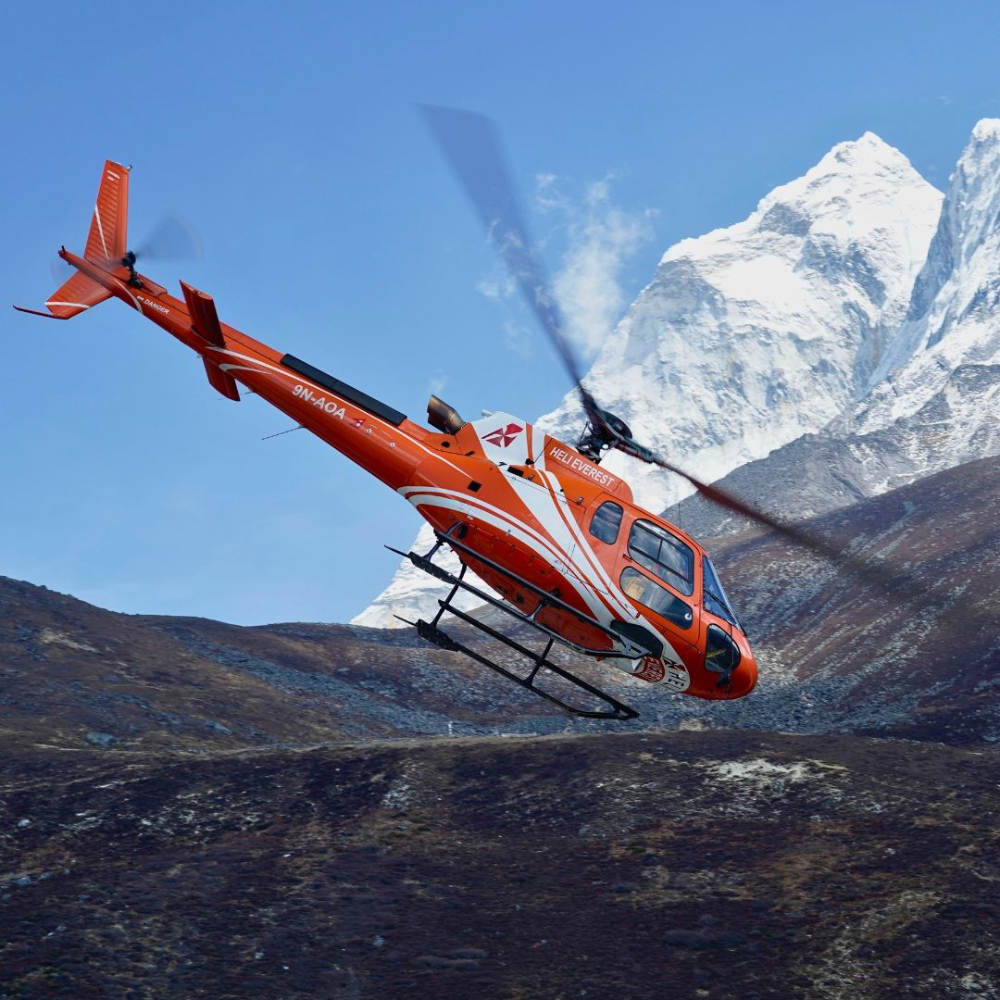
The luxury Everest Base Camp trek with helicopter return is designed to save time and avoid backtracking. After reaching Base Camp and Kala Patthar, a private helicopter flies you from Gorak Shep to Kathmandu.
This avoids 3–4 days of repeat hiking back to Lukla and removes weather-related flight delays. Your trip begins with a helicopter flight from Kathmandu to Lukla, skipping queues at the domestic terminal.
This Everest Base Camp trek by helicopter also offers rare scenic views, including glacial rivers, Sherpa villages, and high ridgelines. Flights typically operate in the morning, when visibility is best for viewing Everest and Ama Dablam from the sky.
These flight segments are practical and scenic, making the trip more efficient for travellers on tight timelines.
Also, check Pokhara-Annapurna Base Camp Helicopter Tour with Guaranteed Landing
Detailed Itinerary: Everest Base Camp Luxury Lodge Trek with Helicopter Return
This luxury Everest Base Camp trek is designed for comfort, proper acclimatisation, and efficient travel with a helicopter return.
Below is a day-by-day breakdown of what to expect, from arrival to your final scenic flight back.
Day 1: Arrive in Kathmandu (1,400m / 4,593ft)
You land at Tribhuvan International Airport. Our team welcomes you and handles your transfer to your hotel. After check-in, rest and hydrate. No physical activity is scheduled for this day.
We recommend an early arrival in Kathmandu to allow time for gear checks and a short trek briefing.

Day 2: Explore Kathmandu and Prepare for Trek
Today is for acclimatising in the city. You may visit key heritage sites like Boudhanath or Swayambhunath. A pre-trek briefing will take place in the evening with your Sherpa guide and trek manager.
The gear is checked. Altitude safety is explained. Any last adjustments will be handled today.
Day 3: Helicopter to Lukla (2,860m) and Trek to Phakding (2,610m)
Fly by helicopter from Kathmandu to Lukla in the early morning. The flight takes about 45 minutes. You’ll land at Tenzing-Hillary Airport, one of the world’s most scenic airstrips.
From Lukla, begin walking with your guide and porters. The trail descends to Phakding beside the Dudh Koshi River. Cross suspension bridges and pass villages like Cheplung and Ghat. Overnight at Yeti Mountain Home, Phakding.
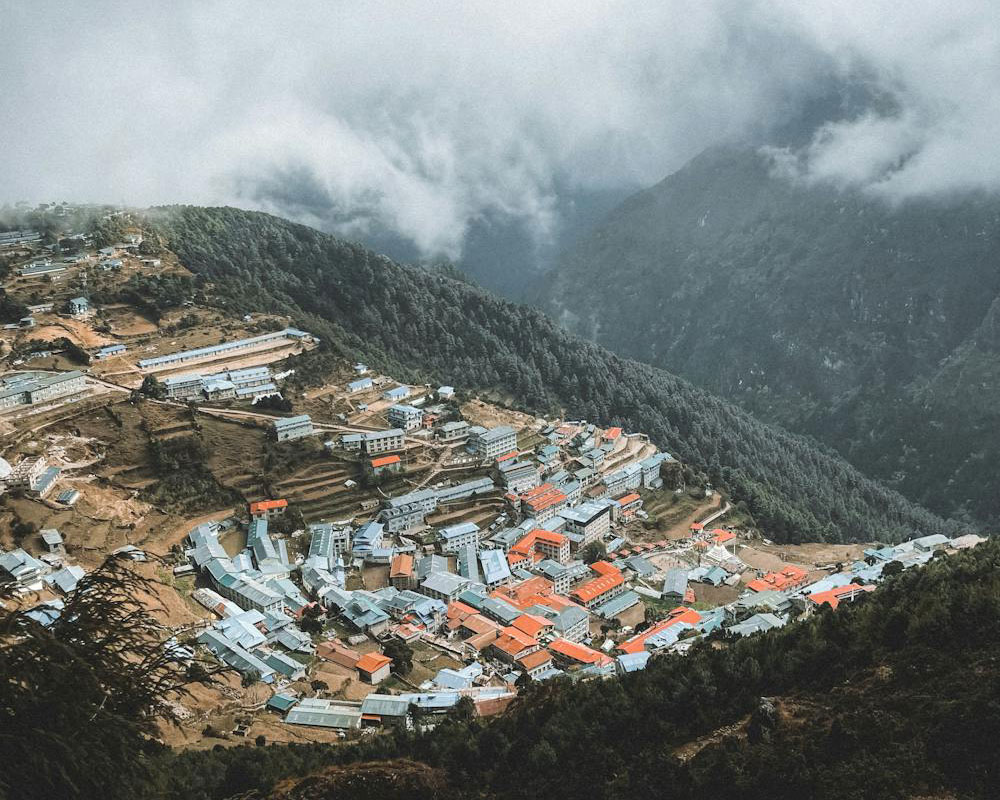
Day 4: Trek from Phakding to Namche Bazaar (3,440m)
Start early for a full-day trek to Namche Bazaar, the main Sherpa town in the Khumbu region. You’ll enter Sagarmatha National Park after Monjo and cross the Hillary Suspension Bridge.
The trail climbs steeply to Namche, with views of Thamserku and Kusum Kanguru. Arrive and stay at Yeti Mountain Home, Namche. Your lodge has heated rooms and a full-service dining area.
Day 5: Acclimatisation at Namche Bazaar
Rest and acclimate to the elevation. Hike to Syangboche Airstrip or visit the Sherpa Museum. An optional walk to Hotel Everest View offers panoramic views of Everest, Lhotse, and Ama Dablam.
You’ll return to Namche for lunch and relax for the afternoon. This stop helps reduce altitude sickness risk. Markets open on Saturdays with locals trading vegetables, yak cheese, and Tibetan goods.
Day 6: Trek to Debuche (3,860m)
Leave Namche and climb to Kyangjuma, then descend to Phunki Thenga by the river. You’ll pass rhododendron forests and small prayer wheels along the way.
After lunch, ascend through stone steps to reach Tengboche Monastery, the largest in Khumbu. Walk 20 minutes downhill to Mountain Lodges of Nepal in Debuche, a quieter stopover below Tengboche.
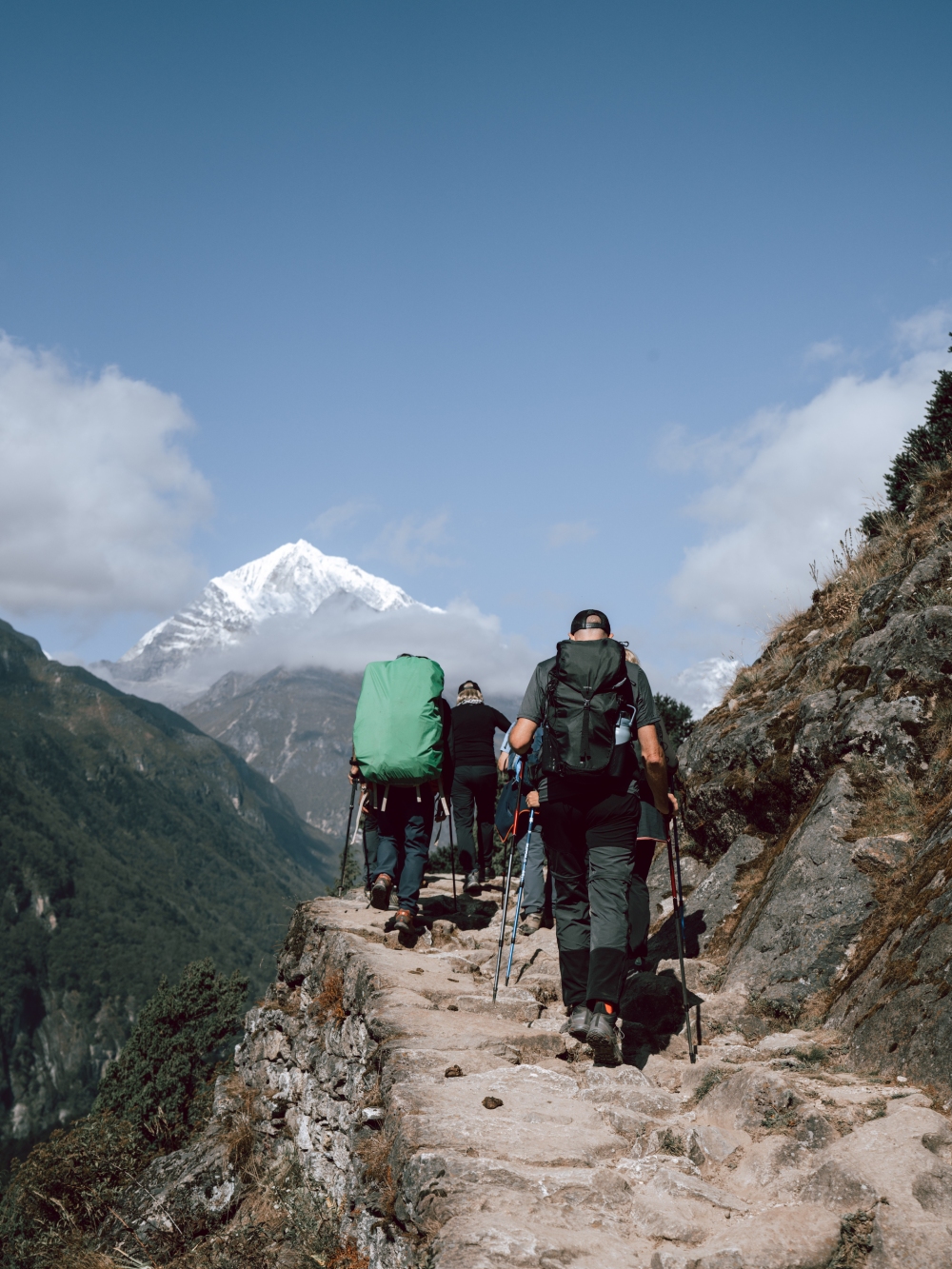
Day 7: Trek to Dingboche (4,410m)
Start early and walk past Pangboche and Milingo, crossing bridges over the Imja Khola. Prayer flags and mani walls line the trail. Ama Dablam towers above for most of this route.
You’ll reach Dingboche by mid-afternoon. The village sits between farmland protected by stone walls. Overnight at Hotel Tashi Delek, a warm lodge with clear views of Island Peak and Lhotse.
Day 8: Acclimatisation Day at Dingboche
You’ll hike up to Nangkartshang Viewpoint or Nagarjun Hill above 5,000m for gradual elevation exposure. Take it slow and return to Dingboche for a hot lunch and rest.
This day is critical for your body to adjust before heading above 5,000 meters. Optional village walks can be arranged with your guide in the evening.
Day 9: Trek to Lobuche (4,940m)
The trail starts gently and climbs toward Dughla, where you’ll stop for lunch. A steep climb leads to the Everest Memorials, a tribute to fallen climbers like Scott Fischer.
Continue to Lobuche along the Khumbu Glacier's edge. The trail gets windier and rockier at this height. You’ll sleep in a lodge with shared facilities. Hot drinks and warm meals are available.
Day 10: Trek to Everest Base Camp (5,364m) and Return to Gorak Shep (5,164m)
This is a long and rewarding day. Begin walking from Lobuche toward Gorak Shep, your last settlement. Drop bags at the lodge, then hike along the glacier ridge to Everest Base Camp.
At Base Camp, explore glacial rubble, ice pinnacles, and expedition tents (spring season). After time at Base Camp, return to Gorak Shep and rest overnight.
Day 11: Hike to Kala Patthar (5,644m) and fly to Kathmandu by Helicopter
Early morning hike to Kala Patthar for Everest’s best sunrise views. From here, see Everest, Nuptse, Lhotse, Pumori, and Lingtren all at once.
Descend to Gorak Shep and take your helicopter flight back to Kathmandu. The return flight saves three days of walking and gives an aerial finale to your journey.
This is the highlight of the luxury Everest Base Camp trek with a helicopter return.
Day 12: Departure from Kathmandu
You’ll be transferred to the airport based on your flight time. If you have extra days, you may explore Patan or Bhaktapur before leaving Nepal.
Our team will assist with final departure logistics. This marks the end of your Everest journey.
Route Map: Everest Base Camp Luxury Lodge Trek
Using a bigger map can be hectic. Thus, we have got you covered with the easy-to-use map with the best trekking route here:
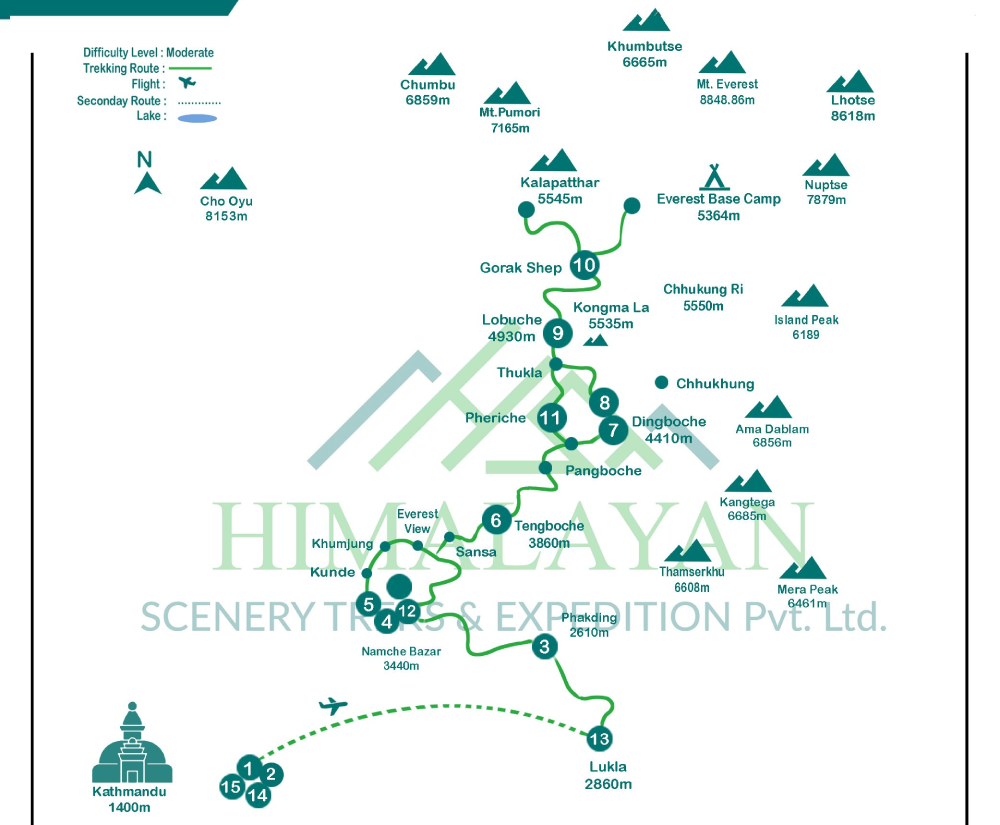
Where You’ll Stay: Luxury Lodges & Hotels on the Trek
Luxury Everest Base Camp trek accommodation includes upgraded mountain lodges and full-service hotels in Kathmandu.
Kathmandu (1,400m)
Your stay begins in Kathmandu, where options vary based on your preference and travel budget. Top choices include the 5-star. Namely, The Dwarika’s, Hyatt Regency, Marriott Kathmandu, Aloft, and Hotel Yak and Yeti. All of them provide breakfast, easy city access, and 24-hour service with Wi-Fi and hot showers.
Phakding to Deboche (2,610m–3,820m)
In Phakding, Namche, and Deboche, you’ll stay in Yeti Mountain Homes, part of Mountain Lodges of Nepal. Rooms are insulated and include heated beds with clean linens, backup solar heating, and sit-down dining areas. Attached bathrooms are available in all rooms, with hot showers and warm drinks on request.
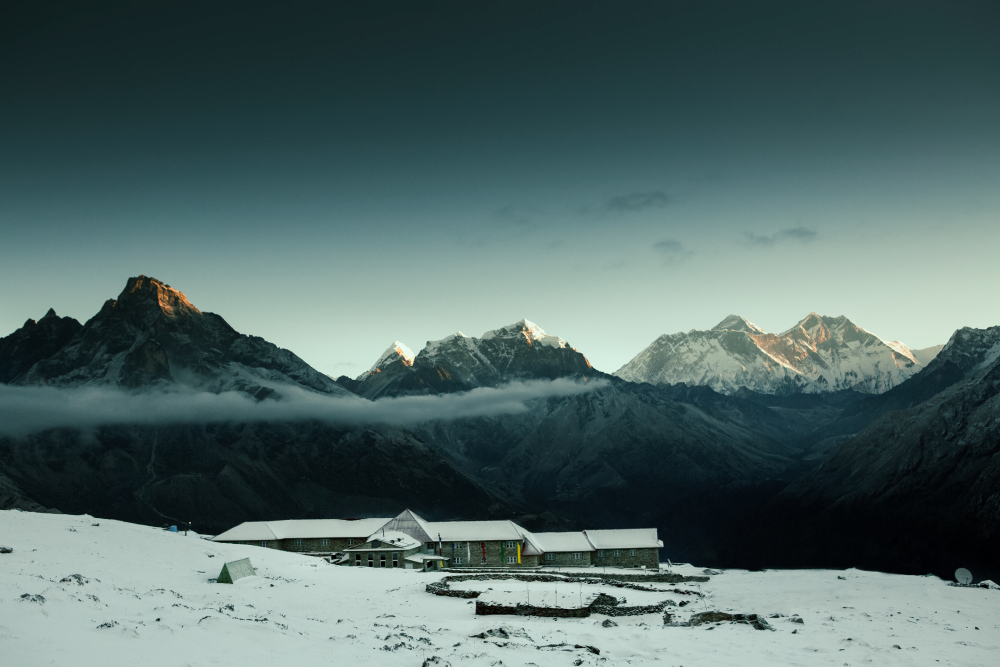
Dingboche (4,410m)
At Dingboche, you’ll stay at Hotel Tashi Delek, a reliable stop above 4,000 meters. Private rooms are available with attached bathrooms. Hot meals and tea are served in a group dining room with limited heat. The lodge offers solar-powered showers when weather allows.
Lobuche and Gorak Shep (4,940m–5,164m)
These high-altitude lodges are clean but limited in service due to elevation and weather conditions. You will have a private room, but the toilets are shared. Electricity is solar-based and available only for short durations.
Expect basic meals. Hot drinks and extra blankets are always offered. Showers are not guaranteed this high up.
When to Go: Best Time for Luxury Everest Base Camp Trek
The best time for the luxury Everest Base Camp trek is in spring and autumn. This ensures the best combination of weather, visibility, and cultural experience.
Spring (March–May)
- Spring brings clear skies and warmer weather.
- Day temperatures can reach up to 20°C (68°F).
- Nights are colder, around -5°C (23°F).
- Rhododendrons bloom in full, adding colour to the trails.
- Visibility is reliable, with less rain and stable weather.
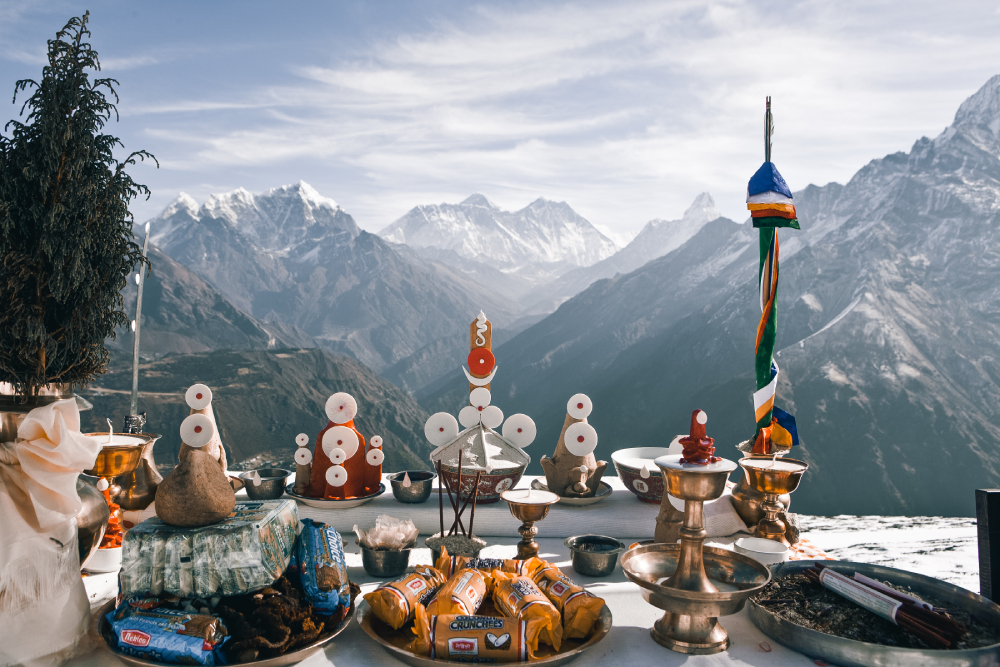
Autumn (September–November)
- Autumn offers crisp air and clear mountain views.
- Temperatures range from 10°C to 12°C (50°F to 54°F) during the day.
- Nights get colder, between -10°C and -20°C (14°F to -4°F).
- This is also festival season, including Dashain and Tihar, enriching local culture.
- The weather is stable, with low chances of rain or clouds.
Seasons to Avoid
- Winter brings heavy snowfall and very low temperatures.
- Monsoon (June to August) causes heavy rain and landslides.
- Clouds often hide mountain views, and Lukla flights may get cancelled.
Everest Base Camp Luxury Trek vs Standard Trek: What’s the Difference?
| Feature | Standard Trek | Luxury Trek |
|---|
| Lodging | Basic tea houses | Luxury lodges |
| Meals | Set menu | À la carte options |
| Flights | Lukla by aeroplane | Helicopter transfer |
| Guide | Group guide | Private Sherpa guide |
| Duration | About 14 days | 11–12 days |
Packing List for Your Luxury Everest Trek
Clothing
- Moisture-wicking base layers (tops and bottoms)
- Insulating layers (fleece, down jacket)
- Waterproof and windproof jacket and pants
- Trekking pants (convertible recommended)
- T-shirts and underwear
- Warm hat, gloves, sun hat or cap
- UV-protection sunglasses
- Wool or synthetic hiking socks
- Sturdy trekking boots and camp shoes
Gear
- Backpack (40–50 litres)
- Sleeping bag rated for cold temperatures
- Sleeping pad or insulated mat
- Trekking poles (optional but helpful)
- Headlamp with extra batteries
- Insulated water bottles or a hydration system
- Durable duffel bag for porter use
- Daypack for essentials
Personal Items
- Biodegradable toiletries (soap, toothbrush)
- Lip balm with SPF
- Hand sanitiser and wet wipes
- Personal medications and a basic first aid kit (however, carried by our guide)
- Insect repellent
- Passport, permits, and travel insurance documents
- Cash in local currency and USD
- Snacks like energy bars and nuts
- Camera or smartphone
- Portable charger or power bank
Important Notes:
- Porters carry your luggage; max weight is 10-12 kg per trekker, for two trekkers.
- We provide a durable duffel bag for porter packing.
- Dress in layers to adjust to changing temperatures.
For a detailed full checklist, visit: Full Packing Checklist for Luxury Everest Base Camp Trek
Conclusion
The luxury Everest base camp trek offers more than just stunning views. It delivers deep emotional satisfaction. Safety and comfort are priorities, letting you focus on the journey without worry.
Cultural exposure with private guides connects you closely with Sherpa traditions and daily life.
At present, many travellers prefer the helicopter return. It saves time and offers spectacular aerial views.









